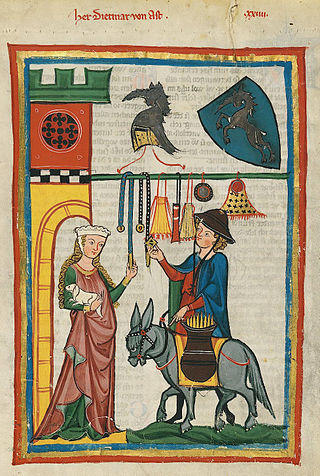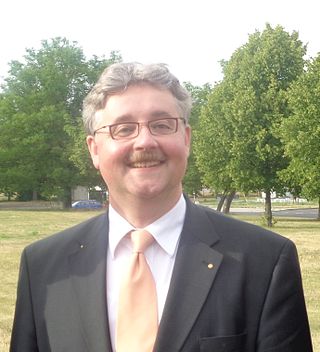Related Research Articles

Hildegard, was a Frankish queen consort who was the second wife of Charlemagne and mother of Louis the Pious. Little is known about her life because like all other women related to Charlemagne, she became notable only from a political background with records on her parentage, wedding, death and role as a mother.

Dietmar von Aist was a Minnesinger from a baronial family in the Duchy of Austria, whose work is representative of the lyric poetry in the Danube region.

Princely count William III of Henneberg-Schleusingen was a member of the House of Henneberg. He was the son of William II of Henneberg and Catherine of Hanau. William III inherited the princely county of Henneberg in 1440, when his father died in a hunting accident. In 1469, he married Margaret, the daughter of Duke Henry the Peaceful of Brunswick-Lüneburg.

The Naumburg Master was an anonymous medieval stone sculptor. His works date to the middle of the 13th century, were executed over a career of more than thirty years, and are counted among the most important artworks of the European Middle Ages.

The lokator was a medieval sub-contractor, who was responsible to a territorial lord or landlord for the clearing, survey and apportionment of land that was to be settled. In addition, he hired settlers for this purpose, provided their means of subsistence during the transitional period and made materiel and implements available, such as seed, draught animals, iron ploughs, etc. He thus played a key role during the establishment of new towns and villages, as well as the clearing of uncultivated land during the phase of internal colonisation (Binnenkolonisation) in North German and the German Ostsiedlung and participated in its success.

Michael Matheus is a German historian.
Willibald Sauerländer was a German art historian specializing in Medieval French sculpture. From 1970 to 1989, he was director of the prestigious Zentralinstitut für Kunstgeschichte, Munich.
Friedrich Wilhelm Karl, Ritter von Hegel was a German historian and son of the philosopher Georg Wilhelm Friedrich Hegel. During his lifetime he was a well-known and well-reputed historian who received many awards and honours, because he was one of the major urban historians during the second half of the 19th century.
Friedrich Lütge was a German economist, social historian and economic historian.
Ellen Widder is a German historian.
Peter Ludwig Gülke is a German conductor and musicologist.
Peter Baumgart is a German historian.

Friedrich Uhlhorn was an honorary professor at the Philipps-Universität Marburg, whose scientific focus was on the history of the State of Hesse and was also known for his work outside Hesse. His special scientific interest was mainly focused on the problems of historical cartography. In collaboration with Edmund Ernst Stengel, he published the Geschichtlichen Atlas von Hessen, which is considered his major work. He also wrote the article Die deutschen Territorien. A: The West, which deals with the West German regional history. Likewise he was responsible as editor for the Hessisches Jahrbuch für Landesgeschichte by Bruno Gebhardt.

Matthias Stickler is a German historian.
Hans Huchzermeyer is a German doctor and musicologist.
Frank-Rutger Hausmann is a German Romanist and historian.

Wolfgang Golther was a German philologist who specialized in Germanic studies. A professor at the University of Rostock, Golther was a prominent authority on Medieval German literature and Germanic religion.
Rudolf Kötzschke was a German historian who founded the Seminar for Regional History and Settlement Studies in Leipzig, the first regional history institution at a German university.
Matthias Untermann is a German art historian and medieval archaeologist.
The Institute of Bavarian History at the Ludwig Maximilian University (Ludwig-Maximilians-Universität) in Munich is a centre of research and teaching of Bavarian history in a European context. It is located in the building complex of the Bavarian State Archives and in the immediate vicinity of the Bavarian State Library.
References
- ↑ Karl Borchardt, Enno Bünz: Peter Herde on his eightieth birthday. In Archive for Diplomatic Affairs 60 (2014), pp. 11–34, here p. 12 (retrieved via De Gruyter Online)
- ↑ Karl Borchardt, Enno Bünz: Peter Herde on his eightieth birthday. In Archive for Diplomatics 60 (2014), pp. 11–34, here p. 13 (accessed via De Gruyter Online)
- ↑ Peter Herde: Contributions to Papal Chancellery and Documentation in the 13th Century. 2nd, improved and extended edition. Kallmünz 1967.
- ↑ Peter Herde: Gestaltung und Krise des christlich-jüdischen Verhältnisses in Regensburg am Ende des Mittelalters. In Zeitschrift für bayerische Landesgeschichte 22 (1959) pp. 359–395 (Numerised).
- ↑ Peter Herde: Die Geschichtswissenschaft an deutschen und amerikanischen Universitäten. Ein Vergleich. In Würzburger medizinhistorische Mitteilungen 21 (2002), pp. 446–463.
- ↑ Cf. the reviews of C. R. Cheney in English Historical Review 79 (1964), pp. 64–67; Georges Tessier in Bibliothèque de l'École des chartes 120 (1962), pp. 207–211; Hans Martin Schaller in Archivalische Zeitschrift 59 (1963), p. 214.
- ↑ Cf. the reviews of Matthias Thiel in Archivalische Zeitschrift 67 (1971), pp. 210–211; Peter Herde in Deutsches Archiv für Erforschung des Mittelalters. 24 (1968), pp. 531–532 (online).
- ↑ Cf. the review by Knut Wolfgang Nörr in Zeitschrift der Savigny-Stiftung für Rechtsgeschichte: Kanonistische Abteilung 58 (1972), pp. 403–407.
- ↑ Karl Borchardt, Enno Bünz: Peter Herde on his eightieth birthday. In Archive for Diplomatic Affairs 60 (2014), pp. 11–34, here p. 14 (retrieved via De Gruyter Online)
- ↑ Peter Herde: Karl I. von Anjou. Stuttgart among others 1979.
- ↑ Peter Herde: Der Heilige Stuhl und Bayern zwischen Zollparlament und Reichsgründung (1867/68–1871). In Zeitschrift für bayerische Landesgeschichte 45 (1982), pp. 589–662 (Digitalisat).
- ↑ See Max Seckler: "Eine wohlüberlegte Entscheidung". Benedikt XVI. auf dem Weg zum Amtsverzicht. In Jan-Heiner Tück (ed.): Der Theologenpapst. Eine kritische Würdigung Benedikts XVI. Freiburg im Breisgau among others 2013, pp. 529–549, here p. 531; Walter Koller in Deutsches Archiv für Erforschung des Mittelalters 40 (1984), pp. 693–694 (Digitalisat)
- ↑ Celestino V (Pietro del Morrone) 1294. Il papa angelico, a cura di Quirino Salomone, translation by Anna Maria Voci, L'Aquila 2004.
- ↑ Peter Herde: Die ältesten Viten Papst Cölestins V. (Peters vom Morrone). Hannover 2008.
- ↑ Peter Herde: Guelfen und Neoguelfen. Zur Geschichte einer nationalen Ideologie vom Mittelalter zum Risorgimento. Stuttgart 1986.
- ↑ Peter Herde: Bonifaz VIII. (1294–1303). Erster Halbband: Benedikt Caetani. Stuttgart 2015. Cf. the discussions with Werner Maleczek in Deutsches Archiv für Erforschung des Mittelalters 74 (2018), pp. 843–845; Claudia Alraum in Archiv für Kulturgeschichte 101 (2019), pp. 477–478; Klaus Herbers in Zeitschrift für Geschichtswissenschaft. 64 (2016), pp. 285–286; Andreas Fischer in sehepunkte 16 (2016), Nr. 4 [15 April 2016], (online); Lucia Dell'Asta in The Catholic Historical Review 103 (2017), pp. 124–125.
- ↑ Vgl. for example Peter Herde: Mittelalterforschung in der Bundesrepublik Deutschland 1945–1970. In Maria Stuiber, Michele Spadaccini (ed.): Bausteine zur deutschen und italienischen Geschichte. Festschrift zum 70. Geburtstag von Horst Enzensberger. Bamberg 2014, pp. 175–218 (online).
- ↑ Peter Herde: Die Äbtissin Cuthsuuith, Anton Chroust und der Sturz des bayerischen Kultusministers Robert von Landmann (1901/02). In Peter Herde, Anton Schindling (ed.): Universität Würzburg und Wissenschaft in der Frühen Neuzeit. Beiträge zur Bildungsgeschichte zu Ehren von Peter Baumgart anläßlich seines 65. Geburtstages. Würzburg 1998, pp. 231–270. Peter Herde: Anton Chroust (1864–1945). Ein streitbarer Historiker aus Österreich in Franken. In Karl Hruza (ed.): Österreichische Historiker. Lebensläufe und Karrieren 1900–1945. Vol. 2. Weimar 2012, pp. 85–127.
- ↑ Peter Herde: Max Buchner (1881–1941) und die politische Stellung der Geschichtswissenschaft an der Universität Würzburg 1925–1945. In Peter Baumgart (ed.): Die Universität Würzburg in den Krisen der ersten Hälfte des 20. Jahrhunderts. Biographisch-systematische Studien zu ihrer Geschichte zwischen dem Ersten Weltkrieg und dem Neubeginn 1945. Würzburg 2002, pp. 183–251.
- ↑ Peter Herde: Michael Seidlmayer (1902–1961) und der Neubeginn der Würzburger Mediävistik nach 1945. In Würzburger Diözesan-Geschichtsblätter 69 (2007), pp. 205–260. Peter Herde: Michael Seidlmayer (1902–1961). In Fränkische Lebensbilder, vol. 23, 2012, pp. 211–226.
- ↑ Peter Herde: Kontinuitäten und Diskontinuitäten im Übergang vom Nationalsozialismus zum demokratischen Neubeginn. Die gescheiterten Berufungen von Hermann Heimpel nach München (1944–1946) und von Franz Schnabel nach Heidelberg (1946–1947). Munich 2007; Peter Herde: Die gescheiterte Berufung Hermann Heimpels nach München (1944–1946). In Sabine Arend, Daniel Berger, Carola Brückner among others (ed.): Vielfalt und Aktualität des Mittelalters. Festschrift für Wolfgang Petke zum 65. Geburtstag. Bielefeld 2006, pp. 695–737.
- ↑ Peter Herde, Benjamin Z. Kedar: A Bavarian historian reinvents himself. Karl Bosl and the Third Reich. Jerusalem 2011. See the discussion of Frank-Rutger Hausmann in H-Soz-Kult, 21 November 2012, (online).
- ↑ Benjamin Z. Kedar, Peter Herde: Karl Bosl im "Dritten Reich". Berlin among others 2016. Cf. the reviews by Bernhard Unckel in Hessisches Jahrbuch für Landesgeschichte 66 (2018), pp. 253–254 (online); Dirk Walter in sehepunkte 16 (2016), Nr. 4 [15 April 2016], online; Clemens Vollnhals in Bohemia 57 (2017), pp. 483–485 (online); Stefan Jordan in Historische Zeitschrift 305 (2017), pp. 258–260.
- ↑ Benjamin Z. Kedar, Peter Herde: Karl Bosl im "Dritten Reich". Berlin among others 2016, p. 18.
- ↑ Ernst Schütz: The cause Bosl. More questions than clarity. In The High School in Bavaria, No. 10, 2012, pp. 34–37. Dirk Walter: Karl Bosl. Approaching a personality. Achievements - misconduct. With a contribution by Willi Eisele. Munich 2013.
- ↑ Dirk Walter: Karl Bosl. Approach to a personality. Performance - misconduct. With a contribution by Willi Eisele, Munich, 2013, pp. 15–18.
- ↑ Cf. the review by Konrad Fuchs in Nassauische Annalen 116 (2005), pp. 691–692.
- ↑ Takuma Melber: Between Collaboration and Resistance. The Japanese occupation in Malaya and Singapore 1942-1945. Frankfurt 2017, p. 21.
- ↑ Peter Herde: Greater East Asian sphere of prosperity. The Japanese occupation policy in the Philippines and Indonesia during World War II and its consequences. Stuttgart 2002, p. 162.
- ↑ Peter Herd: The Axis Powers, Japan and the Soviet Union. Japanese sources on the Second World War (1941-1945). With comprehensive document section in English language. Berlin 2018. Cf. the reviews of 78 (2019), pp. 292–296; Michael Thöndl in Historische Zeitschrift 309 (2019), pp. 829–830.
- ↑ Mitgliederverzeichnis at the Wayback Machine (archived 2018-08-28)
- ↑ Karl Borchardt and Enno Bünz (ed.): Forschungen zur Reichs-, Papst- und Landesgeschichte. Peter Herde zum 65. Geburtstag von Freunden, Schülern und Kollegen dargebracht. 2 volumes, Stuttgart 1998; Karl Borchardt and Enno Bünz (ed.): Forschungen zur bayerischen und fränkischen Geschichte. Peter Herde zum 65. Geburtstag von Freunden, Schülern und Kollegen dargebracht. Würzburg 1998.
- ↑ Karl Borchardt, Enno Bünz: Peter Herde on his eightieth birthday. In Archive for Diplomatic Affairs 60 (2014), pp. 11–34, here p. 17 (retrieved via De Gruyter Online)